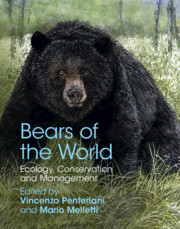Book contents
- Bears of the World
- Bears of the World
- Copyright page
- Dedication
- Frontispiece
- Contents
- Contributors
- Foreword
- Acknowledgments
- Introduction
- Part I Systematics, Ecology, and Behavior
- Part II Species Accounts
- Chapter 6 Giant Panda (Ailuropoda melanoleuca)
- Chapter 7 Andean Bear (Tremarctos ornatus)
- Chapter 8 Sun Bear (Helarctos malayanus)
- Chapter 9 Sloth Bear (Melursus ursinus)
- Chapter 10 Asiatic Black Bear (Ursus thibetanus)
- Chapter 11 American Black Bear (Ursus americanus)
- Chapter 12 Brown Bear (Ursus arctos; Eurasia)
- Chapter 13 Brown Bear (Ursus arctos; North America)
- Chapter 14 Polar Bear (Ursus maritimus)
- Part III Human–Bear Coexistence
- Part IV Conservation and ManagementConservation and Management
- Index
- Miscellaneous Endmatter
- Plate Section (PDF Only)
- References
Chapter 13 - Brown Bear (Ursus arctos; North America)
from Part II - Species Accounts
Published online by Cambridge University Press: 16 November 2020
- Bears of the World
- Bears of the World
- Copyright page
- Dedication
- Frontispiece
- Contents
- Contributors
- Foreword
- Acknowledgments
- Introduction
- Part I Systematics, Ecology, and Behavior
- Part II Species Accounts
- Chapter 6 Giant Panda (Ailuropoda melanoleuca)
- Chapter 7 Andean Bear (Tremarctos ornatus)
- Chapter 8 Sun Bear (Helarctos malayanus)
- Chapter 9 Sloth Bear (Melursus ursinus)
- Chapter 10 Asiatic Black Bear (Ursus thibetanus)
- Chapter 11 American Black Bear (Ursus americanus)
- Chapter 12 Brown Bear (Ursus arctos; Eurasia)
- Chapter 13 Brown Bear (Ursus arctos; North America)
- Chapter 14 Polar Bear (Ursus maritimus)
- Part III Human–Bear Coexistence
- Part IV Conservation and ManagementConservation and Management
- Index
- Miscellaneous Endmatter
- Plate Section (PDF Only)
- References
Summary
This chapter comprises the following sections: names, taxonomy, subspecies and distribution, descriptive notes, habitat, movements and home range, activity patterns, feeding ecology, reproduction and growth, behavior, parasites and diseases, status in the wild, and status in captivity.
- Type
- Chapter
- Information
- Bears of the WorldEcology, Conservation and Management, pp. 162 - 195Publisher: Cambridge University PressPrint publication year: 2020
References
- 7
- Cited by

